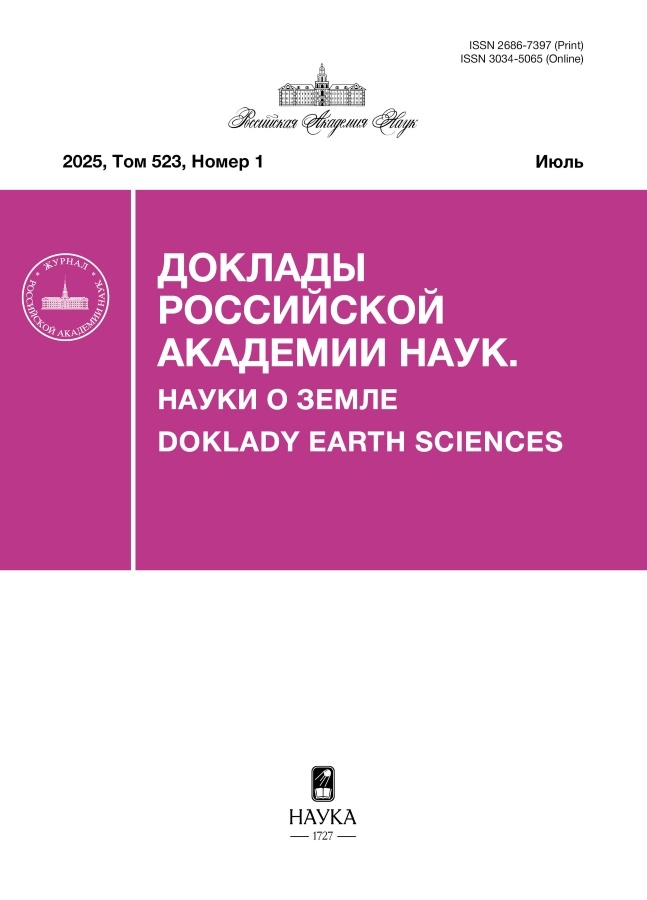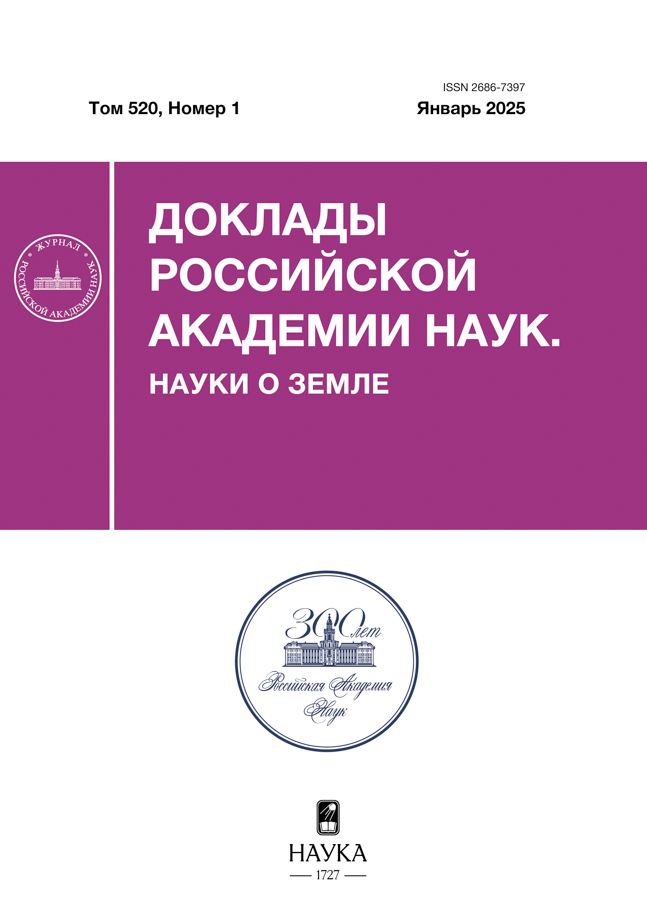Природная среда верхнего Прикамья в позднеледниковье и раннем голоцене по данным изучения донных отложений озера Новожилово
- Авторы: Копытов С.В.1,2, Зарецкая Н.Е.3,4, Константинов Е.А.3, Лаптева Е.Г.5,2, Санников П.Ю.1, Сычев Н.В.3, Мехоношина Е.А.1
-
Учреждения:
- Пермский государственный национальный исследовательский университет
- Пермский государственный гуманитарно-педагогический университет
- Институт географии Российской Академии наук
- Геологический институт Российской Академии наук
- Институт экологии растений и животных Уральского отделения Российской Академии наук
- Выпуск: Том 520, № 1 (2025)
- Страницы: 105-114
- Раздел: ПАЛЕОГЕОГРАФИЯ
- Статья получена: 03.06.2025
- Статья опубликована: 30.05.2025
- URL: https://edgccjournal.org/2686-7397/article/view/682411
- DOI: https://doi.org/10.31857/S2686739725010118
- EDN: https://elibrary.ru/GWGKCI
- ID: 682411
Цитировать
Полный текст
Аннотация
Впервые для бассейна верхней Камы на основе бурения отложений в акватории озера Новожилово (Камско-Кельтминская низменность) получена высокоразрешающая запись природных событий, охватывающая позднеледниковье и ранний голоцен (14150–9730 кал. л. н.). В статье приведены результаты реконструкции условий осадконакопления на основе палеоботанических и седиментологических анализов, а также радиоуглеродного датирования. Началу формирования озера, по-видимому, предшествовал этап преимущественно аллювиального морфолитогенеза, соответствующий предположительно позднему пленигляциалу. В развитии озерной котловины выделяется четыре этапа: первые три с озерно-аллювиальным, преимущественно минерагенным, типом осадконакопления, а четвертый с типично озерным органогенным типом. Первый этап охватывал межстадиал бёллинг-аллерёд 14150–13500 кал. л. н., для него было характерно накопление песков в условиях высокой проточности. На рубеже аллерёда и позднего дриаса значительно возрастает биопродуктивность. В течение второго этапа (13500–12420 кал. л. н.) замедляется водообмен и формируется органо-минеральный озерный ил. Третий этап переходного осадконакопления относится к позднему дриасу – раннему голоцену (12420–10700 кал. л.н.), в течение которого преобладает аллювиальный привнос при снижении содержания органического вещества. Четвертый этап эвтрофного озера (10700–9730 кал. л. н.) характеризуется высоким содержанием органического вещества в осадке, в гранулометрическом составе увеличивается алевритовая фракция.
Полный текст
Об авторах
С. В. Копытов
Пермский государственный национальный исследовательский университет; Пермский государственный гуманитарно-педагогический университет
Автор, ответственный за переписку.
Email: sergkopytov@gmail.com
Россия, Пермь; Пермь
Н. Е. Зарецкая
Институт географии Российской Академии наук; Геологический институт Российской Академии наук
Email: sergkopytov@gmail.com
Россия, Москва; Москва
Е. А. Константинов
Институт географии Российской Академии наук
Email: sergkopytov@gmail.com
Россия, Москва
Е. Г. Лаптева
Институт экологии растений и животных Уральского отделения Российской Академии наук; Пермский государственный гуманитарно-педагогический университет
Email: sergkopytov@gmail.com
Россия, Екатеринбург; Пермь
П. Ю. Санников
Пермский государственный национальный исследовательский университет
Email: sergkopytov@gmail.com
Россия, Пермь
Н. В. Сычев
Институт географии Российской Академии наук
Email: sergkopytov@gmail.com
Россия, Москва
Е. А. Мехоношина
Пермский государственный национальный исследовательский университет
Email: sergkopytov@gmail.com
Россия, Пермь
Список литературы
- Квасов Д. Д. Позднечетвертичная история крупных озер и внутренних морей Восточной Европы. Л.: Наука, 1975. 280 с.
- Назаров Н. Н., Копытов С. В., Жуйкова И. А., Чернов А. В. Плейстоценовые каналы стока в южной части Кельтминской ложбины (Камско-Вычегодское междуречье) // Геоморфология. 2020. № 4. С. 74–88. https://doi.org/10.31857/S0435428120040070
- Panin A. V., Astakhov V. I., Lotsari E., Komatsu G., Lang J., Winsemann J. Middle and Late Quaternary glacial lake-outburst floods, drainage diversions and reorganization of fluvial systems in northwestern Eurasia // Earth-Science Reviews. 2020. Vol. 201. 103069. https://doi.org/10.1016/j.earscirev.2019.103069
- Lysa A., Larsen E., Buylaert J.-P., Fredin O., Jensen M., Kuznetsov D. Late Pleistocene stratigraphy and sedimentary environments of the Severnaya Dvina-Vychegda region in northwestern Russia // Boreas. 2014. Vol. 43. P. 759–779. https://doi.org/10.1111/bor.12080
- Зарецкая Н. Е., Панин А. В., Голубева Ю. В., Чернов А. В. Седиментационные обстановки и геохронология перехода от позднего плейстоцена к голоцену в долине р. Вычегда // ДАН. Сер. Геология. 2014. Т. 455. №1. с. 52–57. https://doi.org/10.7868/S0869565214070238
- Zaretskaya N. E., Panin A. V., Utkina A. O., Baranov D. V. Aeolian sedimentation in the Vychegda river valley, north-eastern Europe, during MIS 2–1 // Quaternary International. 2024. P. 83–89. https://doi.org/10.1016/j.quaint.2023.05.022
- Зилинг Д. Г., Капитанова К. В., Кулагин С. И., Галушкин Ю. А., Симонов А. Н., Корганова Л. С. Отчет о результатах инженерно-геологических исследований, проведенных Камской партией в зоне проектируемого Верхне-Камского водохранилища (на участке от с. Бондюг до с. Гайны) в 1958–59 гг. М.: Мингео СССР, 1960. 830 с.
- Lapteva E. G., Zaretskaya N. E., Lychagina E. L., Trofimova S. S., Demakov D. A., Kopytov S. V., Chernov A. V. Holocene vegetation dynamics, river valley evolution and human settlement of the upper Kama valley, Ural region, Russia // Vegetation History and Archaeobotany. 2023. Vol. 32. P. 361–385. https://doi.org/10.1007/s00334-023-00913-5
- Reimer P., Austin W. E. N., Bard E. et al. The IntCal20 Northern Hemisphere radiocarbon age calibrationcurve (0–55 cal kBP) // Radiocarbon. 2020. Vol. 62. No. 4. P. 725–757. https://doi.org/10.1017/RD C.2020.41
- Heiri O., Lotter A. F., Lemcke G. Loss on ignition as a method for estimating organic and carbonate content in sediments: reproducibility and comparability of results // J. Paleolimnol. 2001. No. 25. P. 101–110. https://doi.org/10.1023/A:1008119611481
- Maher B. A. Magnetic properties of modern soils and Quaternary loessic paleosols: paleoclimatic implications // Palaeogeography, Palaeoclimatology, Palaeoecology. 1998. Vol. 137 (1–2). P. 25–54. https://doi.org/10.1016/S0031-0182(97)00103-X
- Battarbee R. W., Jones V. J., Flower R. J. Diatoms // Tracking Environmental Change Using Lake Sediments. Terrestrial, Algal and Siliceous Indicators. 2001. Vol. 3. P. 155–202.
- Куликовский М. С., Глущенко А. М., Генкал С. И., Кузнецова И. В. Определитель диатомовых водорослей России. Ярославль: Филигрань, 2016. 804 с.
- Чернова Г. М. Спорово-пыльцевой анализ отложений плейстоцена-голоцена. СПб.: Изд-во СПбГУ, 2004. 128 с.
- Prentice C., Guiot J., Huntley B. et al. Reconstructing biomes from palaeoecological data: a general method and its application to European pollen data at 0 and 6 ka // Climate Dynamics. 1996. Vol. 12. P. 185–194. https://doi.org/10.1007/BF00211617
- Белецкая Н. П. Генетическая классификация озерных котловин Западно-Сибирской равнины // Геоморфология. 1987. № 1. С. 50–58.
- Маркова А. К., Кольфсхотен Т., Симакова А. Н., Пузаченко А. Ю., Белоновская Е. А. Экосистемы Европы в период позднеледникового потепления бёллинг-аллерёд (10.9–12.4 тыс. лет назад) по палинологическим и териологическим данным // Известия РАН. Сер. геогр. 2006. № 1. С. 15–25.
- Panin A. V., Matlakhova E. Yu. Fluvial chronology in the East European Plain over the last 20ka and its palaeohydrological implications // Catena. 2015. Vol. 130. P. 46–61. https://doi.org/10.1016/j.catena.2014.08.016
- Садоков Д. О., Сапелко Т. В., Бобров Н. Ю., Меллес М., Федоров Г. Б. Позднеледниковая и раннеголоценовая история озерного осадконакопления на севере Молого-Шекснинской низменности на примере озера Белого (Северо-Запад России) // Вестник СПбГУ. Науки о Земле. 2022. Т. 67. Вып. 2. С. 266–298. https://doi.org/10.21638/spbu07.2022.204
- Палеоклиматы и палеоландшафты внетропического пространства Северного полушария. Поздний плейстоцен – голоцен. Атлас-монография / А. А. Величко, О. К. Борисова, В. П. Гричук и др.; отв. ред. А. А. Величко. М.: ГЕОС, 2009. 119 с.
Дополнительные файлы

Примечание
Представлено академиком РАН С.А. Добролюбовым 02.07.2024 г.














